The Vital Role of Signage and Digital Displays
- By Catherine Dalton
- 02/01/17
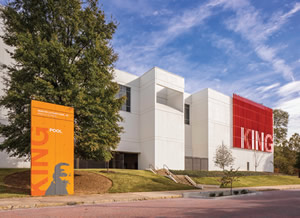
PHOTOGRAPHY BY JONATHAN HILLYER, COURTESY OF PERKINS+WILL
Meet Generation Z — the new class of academic disrupters.
Their size alone demands our attention: demographers
estimate this group to encompass roughly 60 million
children, almost 1 million greater than the preceding Millennial
generation. They are the most culturally diverse and socially aware
generation to date, and will magnify the tech-savvy and multimedia-eager qualities of their earlier peers. At the same time, this
group will have more choice in education than ever before, as the
proliferation of School Choice Programs, Magnet Schools, Charter
Schools and other alternatives make attendance at the “neighborhood
school” no longer a given.
So how do forward-looking institutions adapt in order to create inspiration, drive awareness, build character
and establish a sense of community? To
effectively engage this new generation —
one which efficiently absorbs information
across multiple platforms, discarding it just
as quickly — and to maintain their own future
viability, some schools are integrating
branded experiences into their educational
environments.
Inspiring Community-Mindedness: Martin Luther
King, Jr. Middle School
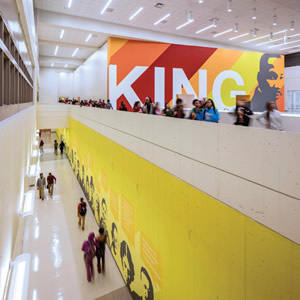
PHOTOGRAPHY BY JONATHAN HILLYER, COURTESY OF PERKINS+WILL
School Brands. One element of the renovation
of the Martin Luther King Jr. Middle School, in
Atlanta, is the inclusion of supergraphics, color
and text to achieve great visual impact that will
appeal to the newest generation of students.
In a 2015 interview with The New York
Times, Millennial Branding’s Managing
Partner Dan Schawbel described a shift
in how Generation Z absorbs messages,
noting that “if they [advertising partners]
don’t communicate in five words
and a big picture, they will not reach this
generation.” School designers can embrace
this change, incorporating supergraphics,
color and text to achieve great visual
impact without spending an extraordinary
amount of money.
Educators have seen how purpose-driven
learning can encourage higher
order thinking in the classroom, so it
stands to reason that higher order thinking
can likewise occur in corridors and
meeting spaces. At MLK Middle School,
Perkins+Will developed multiple graphic
touchpoints to highlight cultural identity
and inspire purpose-driven engagement.
A “freedom wall” featuring a diverse
group of leaders and associated positive
messages runs along the main circulation,
while each learning pod is branded
with a likeness of Martin Luther King,
Jr. and a thought-provoking phrase such
as “what are you doing for others?”.
Although the design team used paraphrased
quotes to build a conversational
language, all text was carefully selected
to address questions frequently asked by
Gen Z such as “why do I have to be here?”,
“who will I become?”, and “why do I need
to learn this?”
The communication benefits of signage
are not restricted to interior environments.
Although traditionally, the school
name is an afterthought of pin mounted
letters hosted to the least significant
wall of the front elevation, MLK features
prominent exterior signage to celebrate
the school’s name, projecting the culture
and identity of the interior outward to the
community at large.
Building Character: Zan
Wesley Holmes Middle School
Zan Wesley Holmes Jr., the middle
school’s namesake, is a Dallas pastor and
political activist who influenced lasting
change benefitting all future generations.
To translate his ongoing legacy — and
the character of resilience, compassion
and integrity he embodies — into the
students’ physical environment, the
design team created signage that includes
Holmes’ likeness and reflections from
his sermons. This connection of person
to place, in conjunction with favorable
character examples, forms a foundation
for the school’s culture.
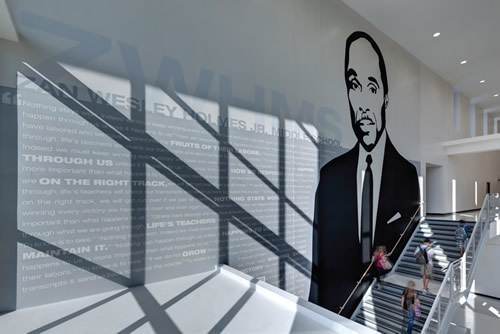
PHOTOGRAPHY BY CHARLES DAVIS SMITH, AIA
Zan Wesley Holmes Middle School, Dallas, Texas
Each of the school’s Small Learning
Centers (SLC) has distinctive colors,
quotes and icons, creating a set of graphic
landmarks by which students, parents,
and volunteers can map their way through
the building. Yet, these wayfinding
elements serve a larger purpose: inspiring
curiosity, grit and an appetite for
learning. Like resilience, compassion and
integrity, these essential traits for success
(in any generation) are not easily found in
a textbook, and are particularly challenging
to teach in an increasingly test-driven curriculum. By elevating these concepts in the physical environment,
the school design aims to enrich youth with strong moral
character, just as Zan Wesley Holmes Jr. enriched society.
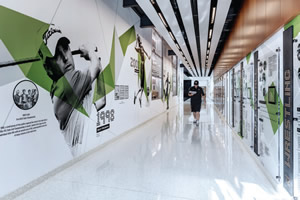
PHOTOGRAPHY BY CHARLES DAVIS SMITH, AIA
Bishop Lynch High School, Dallas, Texas
Curating Motivation: Bishop Lynch High School
While external influences change from generation to generation,
schools can offer internal influences to provide a positive, motivating
message. At Bishop Lynch High School, that opportunity was
afforded by the school’s own history — more than five decades of
academic and athletic legacy. Bishop Lynch, like most schools, has
no staff devoted to the preservation and careful curation of history,
therefore years of student accomplishments were “lost” in crowded
trophy cases and dusty yearbooks. To make their own history accessible
— and motivational — to current and future students, the
school installed a two story tall experiential trophy case featuring
famous alumni and their accomplishments, as well as a feature wall
highlighting athletic achievements. Walking those halls, Gen Z can
be inspired to set goals of adding their name to the list of all-state
players or college scholarship recipients; likewise, the celebration of
student triumphs enhances Bishop Lynch’s recruiting strategy and
deepens the sense of school pride.
Engaging Socially: Little Elm High School
Little Elm High School’s suite of displays originated as a
signage solution to a branding challenge. Using the school’s
mascot, the lobo, as inspiration, the design team developed large
format graphics and crafted names for social spaces. The positive
family-like connotation of a “wolf pack” was emphasized to
create a sense of community through messages such as “Little
Elm, Big Pack” and “Your Pride, Our Pack” and spaces labeled
the “Alpha Café” and “the Den”. Beyond signage, digital displays
were added to enhance the user experience and extend the sense
of community beyond the walls of the school. These highly
flexible displays can be altered to reach different user groups
(students, teachers, parents), can evolve with every new generation,
and can be reactive to global issues in real time.
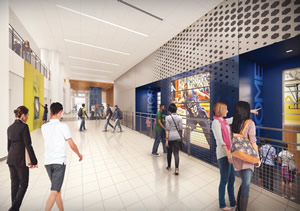
PHOTO COURTESY OF PERKINS+WILL
Little Elm Interior, Little Elm, Texas
Little Elm High School includes several tiers of digital integration.
Upon entry, a selfie wall featuring the motto “Engage, Equip,
and Empower” encourages students to post images to apps such
as Instagram, Twitter, and Snapchat — a type of sharing which is
intuitive to Gen Z and facilitates a social community that mirrors the
traditional physical community. The next level of digital integration
consists of monitors with one-way communication from administration
to students strategically placed at the entrance to each educational
department. These digital moments aid in wayfinding and
display department-specific notifications and achievements. Little
Elm’s highest level of digital integration occurs at the main gymnasium
entry, where a bank of ten monitors enable two-way communication:
in addition to school-produced content, individual students
and attendees can send live feeds to the community at large.
So why should schools consider incorporating a branded experience
for their students? Empowered by School Choice Programs,
Magnet Schools, the recent boom in Charter Schools, home schooling
and increasing financial assistance for private schools, tomorrow’s
generation of students will have more choices than ever when
selecting an educational environment. Simply put, schools are
the manufacturers, education is the product they are selling, and
branding merges product with place. Generation Z will select an
educational environment with a specialized infrastructure that
enables its unique forms of communication, with emphasis on
graphics, technology and highly social connections.
This article originally appeared in the issue of .